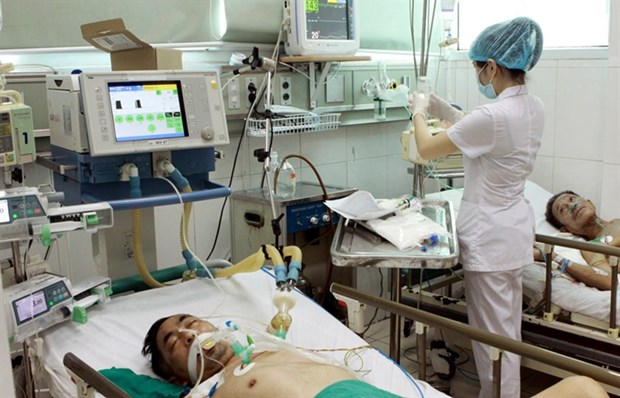New plan to curb infections in hospitals, health centres
Vietnam’s national action plan for prevention and control of hospital infections between 2016 and 2020 will focus on improving effectiveness at health facilities to ensure patient and staff safety.
 Patients with infectious diseases are treated at the Hanoi-based National Hospital of Tropical Diseases (Photo: VNA)
Patients with infectious diseases are treated at the Hanoi-based National Hospital of Tropical Diseases (Photo: VNA) The plan, issued on July 6 at a conference held in HCM City, aims to improve policies, technical processes and professional documents.
Accordingly, more than 80 percent of hospitals in the country will have standard sterilisation units by 2020. Currently, 46.5 percent lack the units.
Software, tools and a database for a national surveillance system on control of hospital infections will be set up in 2017.
More than 50 percent of provincial-level hospitals will carry out surveillance and will quarantine patients with microorganisms that are resistant to antimicrobials.
They will report periodically to the national surveillance system in 2018.
Under the plan, more than 70 percent of hospitals in the country will keep watch on microorganisms in water, air and surface at areas with a high risk of transmission such as rooms for surgery, drip feeds and dialysis in 2018.
At least three centres on training for control of hospital infections will be established at hospitals in the northern, southern and central regions.
Dr Luong Ngoc Khue, Head of Health Examination and Treatment Department, told Vietnam News that the implementation of more and more medical techniques required an increased control of infections.
“Hospital infections occur in not only Vietnam but around the world. However, the rate of hospital infections in the country is still higher than in other countries,” Khue said.
A study conducted by the National Hospital of Tropical Diseases in 2013 among 3,671 patients at 15 intensive care units in 15 hospitals in the northern, southern and central regions showed that the rate of hospital infections was 27.3 percent.
The central-level hospitals had a higher rate of such infections.
Tran Minh Hiep, Deputy Head of Nguyen Dinh Chieu Hospital, complained that the hospital had an Infection Control Ward, but the control’s effectiveness was still low.
Because the hospital was built tens of years ago, the building and its facilities do not meet the Ministry of Health’s regulations on hospital infection control, Hiep said.
Le Van Tuan of the World Health Organisation in Vietnam said that each hospital should create a detailed plan according to its conditions and seek sources for funds to implement the plan based on the national regulations.
Roles of patients and care givers
Dr Nguyen Thi Thanh Ha, Deputy Chairwoman of the HCM City Infection Control Society, said that patients and their relatives who take care of them during their stay at hospitals should join hands with health staff to prevent infections.
Hospital infections could worsen diseases, prolong hospital stays and, most importantly, create microorganisms resistant to antimicrobials, Ha said.
“Patients and their relatives have low awareness of maintaining hygiene at hospitals, leading to an increase in bacteria.”
It is vital to improve education and encourage them to follow hospital regulations on infection control, especially regularly washing hands, she said.
“Sharing of beds and patient overload at Vietnam’s hospitals offer a conducive environment for infection to increase.”
The Ministry of Health uses infection criteria to assess hospitals as safe for patients or not.
It has also organised many campaigns to reduce the risk of hospital infections - such as one to wash hands among health staffs and patients.
Thu Duc Hospital in HCM City, for instance, organises these campaigns every year. On July 5, the hospital called on staff and patients to sign commitment for hospital infection control.
Ha said one of the challenges to controlling hospital infection in Vietnam is the shortage of professionals specialising in this issue.
These professionals are required to have a deep understanding of environmental hygiene, care and treatment of patients and hospital architecture appropriate for infection control, she said.
Public hospital fees were increased by 30-50 percent last March, with 30 percent of the hikes to be earmarked for infection control, meaning hospitals would have more resources to combat infection, she said.
“Another benefit when hospital infections do not occur is that the cost of antibiotics for treatment reduces.”
According to the Health Ministry, five years after it sent a circular on hospital infection prevention and control, 20.8 percent of hospitals around the country had not set up an infection department as of last year.
More than 93.2 percent had been irregular with surveys on hospital-acquired infection since 2010.-VNA













